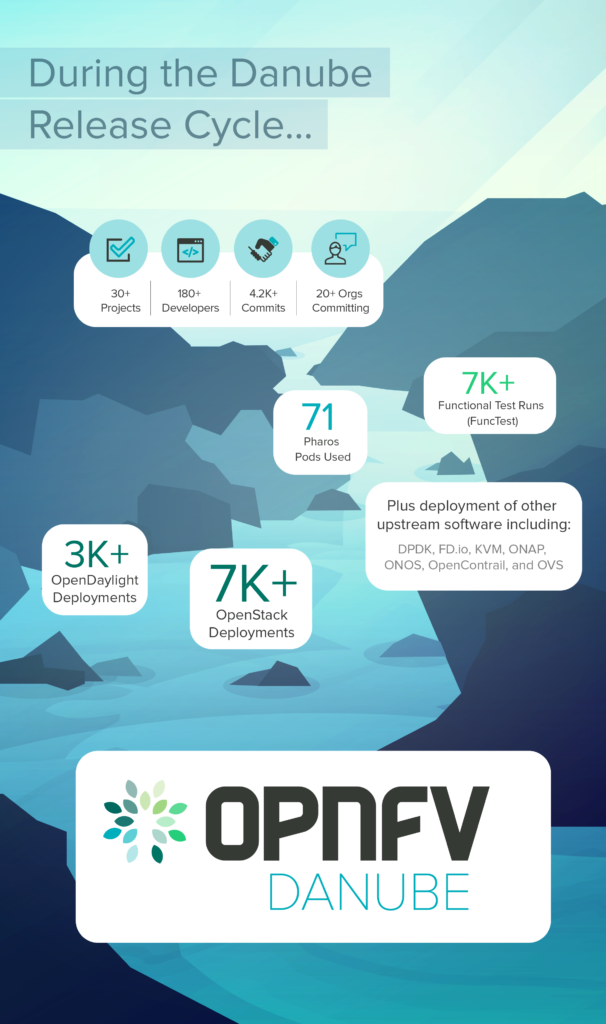OPNFV ‘Danube’ demonstrates ‘create, compose, deploy, test, iterate’ playbook to enable state-of-the-art open source NFV
SANTA CLARA, Calif.—Open Networking Summit—April 4, 2017 — The OPNFV Project, an open source project that facilitates the development and evolution of Network Functions Virtualization (NFV) components across various open source ecosystems through collaborative upstream development, integration, deployment, and testing, today announced the availability of OPNFV Danube, the project’s fourth platform release. As the demand for more robust and agile networks increases, more organizations are looking to technologies such as NFV to bring the scale and flexibility of cloud architecture to networking. The only platform that builds and integrates elements—including functional support for Management and Orchestration (MANO)—across multiple end-to-end open networking stacks, OPNFV Danube introduces key architectural components and evolutionary improvements that meet the needs of end users to enable accelerated NFV.
“Danube represents an evolutionary turning point for OPNFV,” said Heather Kirksey, director, OPNFV. “It brings together full next-gen networking stacks in an open, collaborative environment. By harnessing work with upstream communities into an open, iterative testing and deployment domain, we’re delivering the capabilities that truly enable NFV, and that is very powerful.”
OPNFV Danube brings DevOps methodologies to NFV via collaborative upstream development, integration, deployment, and significant Continuous Integration/Continuous Development (CI/CD) testing automation. Danube also includes continued incremental improvements in baseline features, new advances in network control capabilities, and a growing focus on performance-related topics—especially NFV data plane performance, and instrumentation around MANO functions. With these updates, OPNFV empowers next-generation networking for NFV.
Key enhancements available in OPNFV Danube include:
- Foundational support and introduction of capabilities for MANO: Integration between NFV Infrastructure/Virtual Infrastructure Manager (NFVI/VIM) with Open-Orchestration (Open-O) platform (now ONAP); instrumentation of NFVI network telemetry to support Service Assurance and other use cases; multi-domain template support (Domino project); and translation features between YANG and Tosca modeling languages (Parser project).
- Enhanced DevOps automation and testing methodologies bring a fully integrated CI/CD pipeline, the creation of Lab-as-a-Service (LaaS) to enable dynamic provisioning of lab resources, the introduction of stress testing into the OPNFV test suite, and a Common Dashboard that provides a consistent view of the testing ecosystem.
- Focus on NFV performance including acceleration of the data plane via FD.io integration for all Layer 2 and Layer 3 forwarding (FastDataStacks project), and continued enhancements to OVS-DPDK and KVM. The release also sees a renewed focus on performance test project activities through virtual switch testing (VSPERF project), root cause analysis for platform performance issues (Bottlenecks projects), initial compute subsystem performance testing to lay the groundwork for Benchmarking As a Service (QTIP project), and storage subsystem performance testing (Storperf project).
- Key NFV architectural enhancements, including the ability to dynamically enable and configure network control through integration with OpenStack Gluon and increased reliability and test cases that support multi-site and High Availability (HA) work.
- Feature enrichment and hardening in core NFVI/VIM functionality such as IPv6, Service Function Chaining (SFC), L2 and L3 Virtual Private Network (VPN), fault management and analysis, and a continued commitment to support multiple hardware architectures, as well as traditional hardware OEMs, whitebox, and open source hardware through collaboration with the Open Compute Project.
“We’re seeing the culmination of over two years’ of collaborative work from across the community really come together with the release of OPNFV Danube,” said Tapio Tallgren, lead software architect in Mobile Networks Architecture & Technology, Nokia, and chair of the OPNFV Technical Steering Committee (TSC). “Things like real foundational support for MANO, OPNFV’s sophisticated testing, and DevOps and CI/CD model propel the project into a more robust industry platform for advanced open source NFV.”
Looking ahead, the next OPNFV release, labelled ‘Euphrates,’ will include even more vigorous features and capabilities. For example, the community will be expanding MANO support via collaboration with ONAP to integrate the ECOMP and Open-O code base as it matures, the cross-community CI/CD model will be enhanced, and the platform will include a focus on VNF interoperability and application enablement. OPNFV will also continue to improve native support for LXC/LXD and Kubernetes. Additionally, the project will be building out analytics capabilities through integration with both the PNDA and ONAP projects.
Information about OPNFV Danube is available here: https://www.opnfv.org/software. For information on how to participate in the OPNFV project, visit: https://www.opnfv.org.
Comments From End Users
CableLabs®
“The OPNFV Danube release is an important milestone,” said Tetsuya Nakamura, principal architect, Strategy and Innovation Group, CableLabs. “The strong integration testing enables us to utilize Danube as the basis for our NFV/SDN R&D reference platform, which we plan to use to accelerate cable industry test cases such as virtualized cable access provisioning through our subsidiary Kyrio’s interoperability lab.”
Orange
“We are looking forward to the Danube release and have started integrating the new Danube DevOps methodologies and overall OPNFV testing components into our integration center, leveraging OPNFV as a key component of our NFV platform,” said Emmanuel Bidet, vice president, Convergent Networks Control, Orange. “We have high expectations of Danube as the fourth OPNFV release, and are happy to welcome the community for release testing during the next OPNFV Plugfest, which we’ll be hosting at the Orange Gardens near Paris, at end of April.”
Telecom Italia
“OPNFV plays a key role in the telco software-centric network transformation by rapidly building an open and integrated foundation, collaboratively working with upstream communities,” said Cecilia Corbi, senior project manager, Standard Coordination & Industry Influencing Technology department, Telecom Italia. “The Danube release represents a relevant milestone for the maturity and robustness of the platform by including advanced features and scenarios that accelerate development of NFV applications and services. Via a strong focus on continuous integration/deployment (CI/CD) and testing, coupled with many capabilities that enable network flexibility and agility, OPNFV has become an asset for telco operators as they transform their networks.”
OPNFV is onsite at the Open Networking Summit in Santa Clara, Calif. this week, participating in various presentations and demos throughout the Summit. Learn more about OPNFV participation at ONS throughout the week.
The third OPNFV Plugfest will be held April 24-28 at the campus of member company Orange in Chatillon, France. The event will focus on interoperability of the OPNFV platform in three key areas of testing: OPNFV Deployment, Network Integration, and VNF Applications. Both OPNFV members and non-members are welcome to attend.
OPNFV is hosting its third OPNFV Summit in Beijing, China (June 12-15). The event will feature both a Design Summit—where the OPNFV technical community will convene to continue working on the E-Release with plenary sessions, project breakouts, and social events—and a Summit Conference with keynotes, breakout sessions, a technology showcase, networking opportunities, and much more. More details on sponsorship, attendance and registration are available here: http://events.linuxfoundation.org/events/opnfv-summit
About the Open Platform for NFV (OPNFV)
Open Platform for NFV (OPNFV) facilitates the development and evolution of NFV components across various open source ecosystems. Through system level integration, deployment and testing, OPNFV creates a reference NFV platform to accelerate the transformation of enterprise and service provider networks. For more information, please visit http://www.opnfv.org.
OPNFV is Collaborative Project at the Linux Foundation. Linux Foundation Collaborative Projects are independently funded software projects that harness the power of collaborative development to fuel innovation across industries and ecosystems. www.linuxfoundation.org.
Additional Resources
Get Involved
Download OPNFV Danube
OPNFV Resources
OPNFV Blog

 By Tapio Tallgren
By Tapio Tallgren


